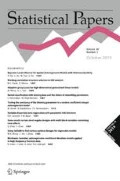Zusammenfassung
Bei der Konstruktion sozioökonomischer Modelle tauchen häufig theoretische Konstrukte auf, die nicht direkt gemessen werden können. Es bietet sich dann an, Modelle mit unbeobachtbaren Variablen zu konstruieren, die indirekt gemessene Variablen zulassen. In diesem Papier wird ein Verfahren dargestellt, der PLS-Ansatz, der zur Schätzung solcher Modelle dient. Ausgehend von einer allgemeinen Formulierung für Modelle mit unbeobachtbaren Variablen wird dieser Ansatz dargestellt, um Unterschiede und Gemeinsamkeiten mit einem alternativen Schätzverfahren, dem LISREL-Ansatz, herauszuarbeiten. Darüber hinaus wird die Frage behandelt, wie PLS-Modelle bewertet werden können und gezeigt, in welcher Weise kausale Effekte in PLS-Modellen zerlegt werden können. Abschließend wird die Konstruktion eines Arbeitsmarktmodells mit unbeobachtbaren Variablen beispielhaft erläutert.
Summary
Socioeconomic models often contain theoretical concepts, which can not be measured directly. Therefore it is useful to construct models with unobservable variables. In this paper a method is discussed, the PLS-approach, which serves for estimation of such models. Starting from a general formulation for models with unobservable variables this approach is outlined and compared with an alternative method, the LISREL-approach. Moreover the evaluation and decomposition of effect in PLS-models is pointed out. Finally the construction of a labour-market model with unobservable variables serves for illustration.
Résumé
Etablissant des modèles socio-économiques on rencontre souvent des concepts théoriques qu'on ne sait pas mesurer directement. Alors la construction de modèles avec des variables non-observables s'offre permettant l'utilisation de variables mesurées indirectement.
Une procédure est discutée dans cette contribution, la méthode PLS, servant à estimer de tels modèles. Cette méthode est expliquée partant d'un généralisation pour des modèles avec des variables non-observables afin que des discrépances et des traits communs envers une méthode d'estimation alternative, celle de LISREL, soient précisées. En plus l'évaluation des modèles PLS et la décomposition d'effets dans ceux-ci sont discutés. La construction d'un modèle du marché de travail avec des variables non-observables sert finalement comme illustration.
Резюме
При образовании социально-экономических моделей часто появляются теоретические элементы, которые нельзя измерить непосредственно. В этом случае полезно образовать модели с ненаблюдаемыми переменными, допускающими непосредственно измеренные переменные.
В этой работе представляется метод частично наименьших квадратов, применяющийся для оценки таких моделей. Исходя из общей формулировки для моделей с ненаблюдаемыми переменными излагается этот метод, а то с целью выработки разниц и общностей с другим методом оценок, с методом линейно-структурного отношения.
Свыше того обсуждается вопрос оценки моделей, разработанных согласно методу частично наименьших квадратов упомянутых моделях каузальные эффекты. В заключение поясняется примерами образование моделей с ненаблюдаемыми переменными для рынка рабочей силы.
Literaturverzeichnis
Apel, H., Simulation sozio-ökonomischer Zusammenhänge. Kritik und Modifikation von “System Dynamics”, Diss. Frankfurt 1977.
Blalock, H.M., Multiple Indicator Models and the Causal Approach to Measurement Error, in: American Journal of Sociology 75 (1969), S. 264–272.
Costner, H.C., Theory, Deduction and Rules of Correspondence, in: American Journal of Sociology 75 (1969/70), S. 245–263.
Cremer, R. und H. Knepel, Ein Indikatorenmodell für sozioökonomische Problembereiche des Arbeitsmarktes, in: Mitteilungen aus der Arbeitsmarkt-und Berufsforschung, 13 (1980), S. 125–136.
Duncan, O.D., Path Analysis: Sociological Examples, in: American Journal of Sociology 72 (1966), S. 1–16.
Etzioni, A. und E.W. Lehman, Zur “gültigen” Messung gesellschaftlicher Tatbestände, in: Fehl, G., Fester, M., Kuhnert, N. (Hrsg.), Planung und Information, Gütersloh 1972, S. 224–245.
Geisser, S., The Predictive Sample Reuse Method with Application, in: Journal of the American Statistical Association, 70 (1975), S. 320–328.
Goldberger, A.S., Maximum likelihood estimation of regressions containing unobservable independent variables, in: International Economic Review 13 (1972), S. 1–15.
Hauser, R.M. und A.S. Goldberger, The Treatment of Unobservable Variables in Path Analysis, in: Costner, H.L. (Hrsg.), Sociological Methodology, San Francisco 1971, S. 81–117.
Hui, B.S., Soft Modelling by the Partial Least Squares Approach, Doctoral Dissertation, University of Pennsylvania 1978.
Jöreskog, K.G., Structural Equation Models in the Social Sciences. Specification, Estimation and Testing, in: Krishnaiah, P.R. (Hrsg.), Applications of Statistics, Amsterdam/New York/Oxford 1977, S. 265–287.
Jöreskog, K.G. und A.S. Goldberger, Estimation of a Model with Multiple Indicators and Multiple Causes of a Single Latent Variable, in: Journal of the American Statistical Association, 70 (1975), S. 631–639.
Jöreskog, K.G. und D. Sörbom, Statistical Models and Methods for Analysis of Longitudinal Data, in: Aigner, D.J., Goldberger, A.S. (Hrsg.), Latent Variables in Socio-economic Models, Amsterdam/New York/Oxford 1977, S. 285–325.
Knepel, H., Sozioökonomische Indikatormodelle zur Arbeitsmarktanalyse, Frankfurt/Main-New York 1981.
Lohmöller, J.B., Estimating Parameters of Linear Structural Relation Models under Partial Least-Squares Criteria, Forschungsbericht 79.01, Hochschule der Bundeswehr München, 1979a.
Lohmöller, J.B., PLSX: Strukturgleichungsmodelle unter Partialkleinstquadratkriterien: Darstellung und Beschreibung des Programms PLSX, Unveröffentlichtes Manuskript, München 1979b.
Lohmöller, J.B., Residuals in PLS-Modelling, Referat gehalten beim “Workshop of Soft Modelling Applications”, Universität Genf 1979c.
Lohmöller, J.B. und H. Wold, Three-Mode Path Models with Latent Variables and Partial Least Squares (PLS) Parameter Estimation, Forschungsbericht 80.03, Hochschule der Bundeswehr München, 1980.
Schmidt, P., Zur praktischen Anwendung von Theorien: Grundprobleme und Anwendung auf Hochschuldidaktik, Diss. Mannheim 1977.
Stegmüller, W., Probleme und Resultate der Wirtschaftstheorie und Analytischen Philosophie, Bd. 2, Theorie und Erfahrung, Berlin/Heidelberg/ New York 1970.
Wold, H., Estimation of Principal Components and Related Models by Iterative Least Squares, in: Krishnaiah, P.R. (Hrsg.), Multivariate Analysis, New York 1966, S. 391–420.
Wold, H., Soft Modeling by Latent Variables: The Non-Linear Iterative Partial Least Squares (NIPALS) Approach. In: J. Gani (Hrsg.), Perspectives in Probability and Statistics. Papers in Honour of M. S. Bartlett, London 1975, S. 117–142.
Wold, H., Open Path Models with Latent Variables. The NIPALS Approach. In: H. Albach; E. Helmstädter; R. Henn (Hrsg.), Quantitative Wirtschaftsforschung, Tübingen 1977, S. 729–754.
Wold, H., Model Construction and Evaluation when Theoretical Knowledge is Scarce. An Example of the Use of Partial Least Squares, Cahiers du Département d'Econométrie, Genf, 1979.
Zellner, A., Estimation of regression relationships containing unobservable variables, in: International Economic Review, 11 (1970), S. 441–454.
Rights and permissions
About this article
Cite this article
Knepel, H. Modelle mit unbeobachtbaren Variablen —Der PLS-Ansatz. Statistische Hefte 22, 248–279 (1981). https://doi.org/10.1007/BF02932468
Issue Date:
DOI: https://doi.org/10.1007/BF02932468

